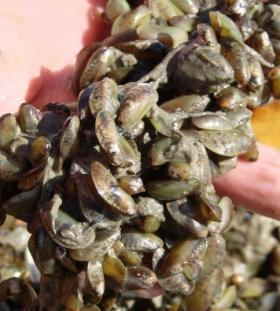Asian date mussel

[Image: Olivia Johnston]
Status in New Zealand
Present in some areas of New Zealand
Legal status:
Under management
Description
Arcuatula senhousia, commonly known as the Asian date mussel, Asian mussel or bag mussel, is a small saltwater mussel. It is native to the Pacific Ocean from Siberia to Singapore but it has spread to numerous locations around the globe incidentally by vessels (as biofouling or larvae in ballast water) and shellfish aquaculture. It inhabits the intertidal and subtidal zones to a depth of 20 metres and larvae preferentially settle on soft substrate but can settle on hard substrate. It lives entirely in the sediment and produces byssal threads that can form extensive mats on the sediment surface when densities are high. The Asian date mussel is fast growing, short lived (maximum 2 years) and can obtain densities of thousands per square metre. Populations typically fluctuate widely in abundance over time.
Why is it a problem?
The Asian date mussel alters benthic habitats through forming dense mats on soft sediments that can displace benthic communities. As it can obtain high densities and is a suspension feed it can limit the amount of plankton available as food for other species. Also anoxic conditions can occur in the sediment water interface due to the production and decomposition of large volumes of faeces and pseudofaeces.
What do they look like?
|
Download an identification guide
- Asian date mussel identification guide (Source: Australian Commonwealth Govt) [397 KB]